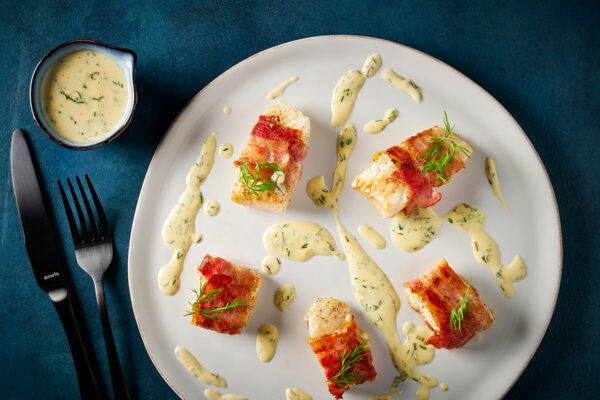Wolffish: What kind of fish is it? And how to cook it?
From frying it, grilling it to cooking it in the oven
Wolffish, an excellent alternative to salmon, is a very versatile fish that you can cook in many ways due to its firm meat.
With wolffish you can put a tasty fish dish on the table in no time. Read more about what this fish has to offer.

Table of contents
- Chapter 1: What kind of fish is wolffish?
- Chapter 2: Where does the fish come from?
- Chapter 3: How does wolffish taste?
- Chapter 4: Is it healthy?
- Chapter 5: Which wine goes with it?
- Chapter 6: How to cook wolffish?
- Chapter 7: Recipe: Wolffish fillet with bacon and lemon sauce
- Chapter 8: All recipes
Chapter 1
What kind of fish is wolffish?
This fish belongs to the family of wolffish and has a characteristic blue-gray upper side with green-brown flanks. Dark vertical bands run along the flanks. The wolffish has a unique and special appearance that makes it different from the rest.
It is also known as the Atlantic catfish and ocean catfish. Just like the monkfish, it is one of the ugliest fish species.
The fish has teeth similar to a wolf’s jaw. The jaw consists of four to six hanging teeth that are quite strong and conical shaped. The lower and upper jaws are the same and it has a central row of four pairs of molars and the outer rows contain blunt conical teeth. The throat is covered with small scattered teeth.
The catfish is elongated in the front and has a smooth texture. The scales are rudimentary. They’re embedded and hide most of their skin. The fish has large, round pectoral muscles and no pelvic fins. Its body resembles that of an eel and therefore it swims very slowly.
During the winter period, the wolffish breeds in deep water. The eggs laid by the female are protected by the male. The eggs hatch after about two months, after which they spend some time in the free water.
The wolffish can grow to a length of 160 cm and weighs about 25 kg. Their food consists of molluscs, shellfish and echinoderms such as the sea cucumber and the sea urchin.
A fun fact is that they not only consume the meat of the wolffish, but also use the firm skin. The skin is mainly used to make shoes, bags and book covers, among other things.
Chapter 2
Where does catfish come from?
Catfish (Wolffish) can be found in areas with a lower water temperature such as Spitsbergen, Norway, the northern North Sea, Great Britain and Iceland up to Greenland.
They’re mainly found on rocky soils and for this reason you will not encounter them in Belgium and the Netherlands.
Chapter 3
How does wolffish taste?
The meat of wolffish is white, firm and juicy and has a mild sweet taste. Because the fish feeds on shellfish and crabs, it has a fine and distinct taste.
Chapter 4
Is it healthy?
Wolffish belongs to the moderately oily fish species and is a good source of vitamins B1, B3 and B6, vitamin B12, phosphorus, selenium and omega-3 fatty acids.
Vitamins B1 and B3 provide the body with energy, ensure the production of fatty acids and ensure proper functioning of the heart muscle and nervous system.
Vitamin B12 ensures the production of red blood cells that are needed to carry oxygen in your blood. Vitamin B12 also ensures the proper functioning of the nervous system.
Phosphorus gives strength to our bones and teeth and selenium protects our red blood cells and cells from damage. Omega 3 fatty acids protect us against cardiovascular disease.
Chapter 5
Which wine goes with it?
The fish goes well with a dry white wine, which is light and fresh and also on the tight side. A fresh Sauvignon de Touraine, a characterful Orvieto or an aromatic Rias Baixas combine well with this fish.
Chapter 6
How to cook wolffish?
You cook wolffish in the same way as monkfish and salmon. You can marinate it, stew it, fry it and poach it, among other things.
Its meat is firm, so the fish does not fall apart quickly during cooking. If there’s still a white membrane on the fish, you must remove it before cooking, otherwise the fish will curl.
Fresh fish is the tastiest, but if you still want to keep it for a while, it’s best to put the fish in the fridge as soon as possible when you get home. At a temperature of a maximum of 4 degrees, you can keep the fish fresh for 1 to 2 days.
Then put the fish at the bottom of the refrigerator, where it’s the coldest. Use a mat so that the moisture from the fish doesn’t come into contact with other food or ingredients. You can also freeze fresh fish by first wrapping it in cling film and keeping it at a minimum temperature of -18 degrees. This way the fish can be kept for about 3 months. If you want to defrost the fish, it’s best to do so in the refrigerator or in the microwave.
160 to 180 grams of fish fillet per person is sufficient. If you are going to cook a whole fish, it is 320 to 360 grams per person.
The soft taste of the fish combines perfectly with chicory, asparagus and fennel.
You can ask the fishmonger to clean the fish for you, but you can also do it yourself.
Cleaning
You can easily clean the wolffish as follows:
- Remove the scales on both sides with the blunt side of a knife.
- Cut off the side fins, dorsal fins and tail fin with kitchen scissors.
- Cut open the belly from tail to head.
- Pull out the organs with your fingers.
- Scrape off any remaining pieces of the organs with a knife.
- Rinse the fish well inside and out with cold running water.
Filleting
How to fillet the fish:
- Cut all the way into the fish along the spine along the dorsal fin and cut the last piece of fillet free from the tail fin.
- Then work your way down the length of the fish from front to back.
- Slide the knife as flat and as close to the bones as possible and cut the fillet completely loose.
- Turn the fish over and repeat the previous steps for the second fillet.
- Then wash the fillets well with cold water and pat dry with kitchen paper.

Frying it in a pan
If you want to fry catfish, you do this at a high temperature.
- Season the fish with some salt and pepper.
- Heat some butter in a frying pan.
- Place the fish in the pan and fry the fish for 6 to 8 minutes until nicely browned and almost done.
- Turn the fillets halfway through.

Grilling on the barbecue
If you want to barbecue the fish, make sure the barbecue is hot.
- Season the wolffish with coarse sea salt and pepper.
- Drizzle the fish with some olive oil and top it with fresh herbs such as thyme, rosemary and sage.
- Secure the spices by tying the fish with kitchen twine.
- Grill the fish at 200 °C for 20 to 25 minutes on the barbecue.
- Turn the fish halfway through.

In the oven
If you want to cook wolffish in the oven, you do this at a medium temperature.
- Preheat the oven to 200 °C.
- Rub the pieces with lemon juice, some salt and pepper and let them rest for a while.
- Then put the fish in an oven dish and slide the dish in the middle of the oven.
- Bake the fish for 15 to 20 minutes until golden brown and cooked through.
Chapter 7
Recipe: Wolffish fillet with bacon and lemon sauce

Wolffish fillet with bacon and lemon sauce
Ingredients
- 500 grams wolffish fillet
- 8 slices bacon smoked
- 150 ml butter lemon sauce with dill recipe
- 4 sprigs dill fresh
- splash sunflower oil
- black pepper freshly grounded
- salt
For the lemon sauce
- 150 ml fish stock possibly made from a stock cube
- 150 ml whipped cream
- 1.5 lemon
- 35 grams butter
- 1 egg yolk
- ½ cup dill fresh
- black pepper freshly grounded
- pinch salt
Instructions
Lemon sauce
- Put the whipped cream with the fish stock in a saucepan and let it reduce by half.
- Add the zest and juice of the lemon and let it evaporate a bit. Season the sauce lightly with freshly grounded pepper and a pinch of salt if desired.
- Finely chop the dill and set aside until just before serving. We finish the last steps for the sauce at the end just before serving the wolffish.
The wolffish
- Cut the wolffish fillet into 16 nice slices and season generously with freshly grounded pepper and a tiny pinch of salt.
- Cut the slices of bacon in half and roll each slice of wolffish fillet in a slice of bacon.
- Heat a small dash of sunflower oil in a non-stick pan and fry the rolled catfish fillet on the bacon for 2 minutes until crispy.
- Turn the fish and let the other side cook for another 2 minutes to ensure this site becomes crispy and golden brown too.
- Remove from the pan and arrange on a platter.
Finish the sauce
- Bring the sauce to a vigorous boil once and then immediately reduce the heat. Add the butter and the egg yolk while beating for another 1 minute. Remove from the heat and continue beating for another 2 minutes until a nice foamy sauce has formed. You can also use a hand blender if you wish.
- Complete with the dill and season with some freshly grounded black pepper if desired.
Chapter 8
All recipes
Looking for more inspiration? Then see below more recipes with wolffish. Or check our fish recipes for even more inspiration.
Wolffish fillet with bacon and lemon sauce
The wolffish owes its name due to its unattractive appearance with a mouth that is [...]
Jan

